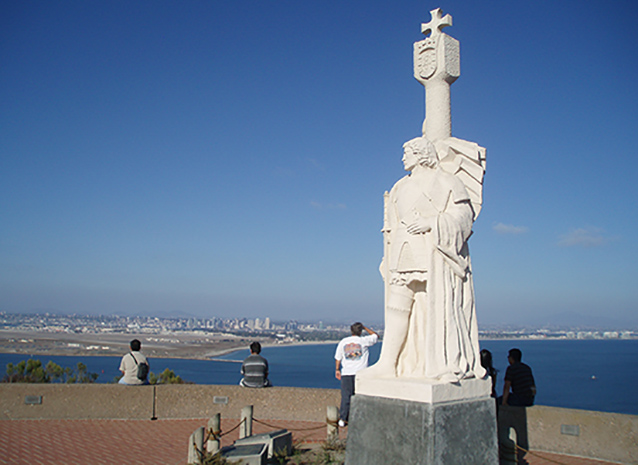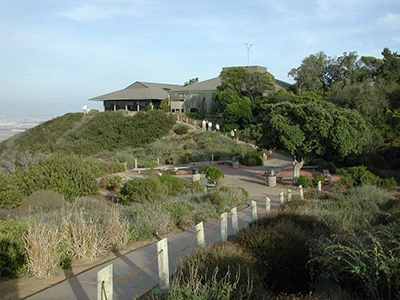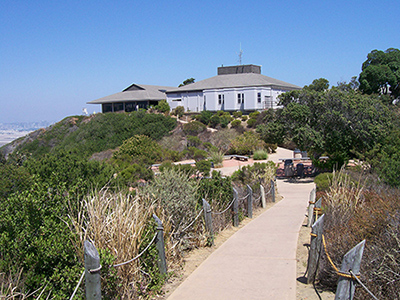The Cabrillo National Monument Visitor Center, constructed in 1963-1967, offers commanding views of the San Diego coast as well as interpretive exhibits and programs.
"...to the memory of Juan Rodriguez Cabrillo and those of all lands who will come here in search of history." Secretary of the Interior Stewart L. Udall, keynote speaker at the dedication of the Cabrillo National Monument Visitor Center, March 7, 1967

NPS
Built as part of the National Park Service's Mission 66 Program, a nationwide effort to revitalize the national parks after World War II, the Cabrillo Visitor Center was designed to represent the National Park Service's modern image.
The Visitor Center is now the most complete and significant expression of the Park Service Modern style, while also being the only of the California Mission 66 visitor centers that provides an example of the Mission 66 program objectives within a southern California coastal context. It displays characteristics of the California school of landscape design, which adapted modernist forms and ideals to California's Mediterranean climate and tradition of utilizing outdoor space.

NPS
Cabrillo National Monument was dedicated on October 14, 1913 in order to commemorate the 1542 landing of the first European expedition to explore the west coast of the United States, led by Juan Rodriguez Cabrillo. The site overlooks San Diego Harbor, the supposed location of the landing, as well as the ocean and surrounding area. The old (inactive) Point Loma lighthouse was already at the site at the time of the monument’s dedication, but the monument’s supporters, led by the San Diegan organization the Order of Panama, dreamt of an even larger landmark.
The plan was to erect a 150-foot-tall statue of Cabrillo in order to draw attention to San Diego and the upcoming Panama-California Exposition. The exposition was planned to coincide with the completion of the Panama Canal, and it would call attention to San Diego's potential as a principal port in the new Atlantic-Pacific sea trade. Though the colossal statue was never erected, Cabrillo National Monument was established.

NPS

NPS
The National Park Service gained control of the monument in 1933. In spite of its large number of yearly visitors, Cabrillo had been considered a second-tier site within the National Park System. Until its expansion in 1959, the monument was completely surrounded by land that was controlled by the military, and during World War II the NPS ceded the site to the army as part of the west coast defense system. For several years, the primary focal point of the site was the old lighthouse.
Despite these obstacles, the park superintendent was determined to bolster the monument’s visibility; it was the only national park in the highly-visited southern California area. Increased development on the site began in the 1930s, with the construction of a state highway leading to the site, a comfort station, restoration work on the lighthouse, and landscaping work. In 1949, a 14-foot tall statue of Cabrillo was erected.
In the early 1960s and with the advent of the National Park Service’s Mission 66, Cabrillo began to receive the funding and support needed to expand and fulfill its goal of telling the story of Juan Rodriguez Cabrillo and other early explorers. Mission 66 was a project undertaken nationally by the National Park Service in tandem with the agency’s 50th anniversary in 1966. In response to greatly increased visitation, particularly by car in the wake of WWII, and in preparation for the 50th anniversary, NPS administrators developed a plan to completely overhaul the park system’s facilities, with an emphasis on improving roads and parking, visitor facilities, and administration, housing areas, and concessionaire areas.

NPS
Conrad Wirth, NPS director during the Mission 66 era, believed that intensive development in contained areas would control public access and prevent deterioration of park resources, promoting a policy that some historians have called the “paradox of protection by development.” Planners modeled the program on national highway and urban renewal programs, believing the solution lay in the modernization of the infrastructure. Characterized by wider roads and larger parking lots, integrated visitor center complexes, a modernist architectural style, and extensive new construction, Mission 66 embraced the latest technologies, materials, and building styles, while moving away from the rustic style that had defined park development for nearly fifty years.
The Visitor Center Historic District at Cabrillo retains its design, materials, and workmanship of its Mission 66 plan. These aspects of the district convey the feeling and association of a Mission 66-era visitor center, combining modern design with the function of serving the park’s visitors while providing a connection to the natural setting.
The major components of the Visitor Center Historic District include the three Visitor Center buildings and associated overlook terraces, the Cabrillo Memorial Statue Overlook, the Ballast Overlook, an entry drive and a large central parking lot, a series of pedestrian pathways, and plant materials that provide a transition between the designed and the natural landscape.

NPS
The three buildings were sited around a central courtyard and were connected by covered walkways. The Visitor Center was sited to overlook (to the north) Point Guijarros, the site where Fort Guijarros, a Spanish fort, stood in 1792. Today, this area is today called Ballast Point. The buildings are designed to emphasize efficient “visitor flow,” as well as centralize park services like information, interpretation, and programs.
The integration of interior and exterior spaces is key to the Cabrillo Visitor Center, achieved through features like window walls and courtyards. The Visitor Center also exemplifies the Mission 66 style of harmonizing buildings with their settings by orienting structures horizontally and using textured concrete that features earth-toned colors. Landscape features reflect their setting as well, incorporating native plants and referencing local elements, such as reflecting the texture and form of an ocean pier in the design of the pergola.
Quick Facts
- Cultural Landscape Type: Historic Designed Landscape
- National Register Significance Level: Local
- National Register Significance Criteria: A, C
- Period of Significance: 1963-1967
Landscape Links
Last updated: November 18, 2020
